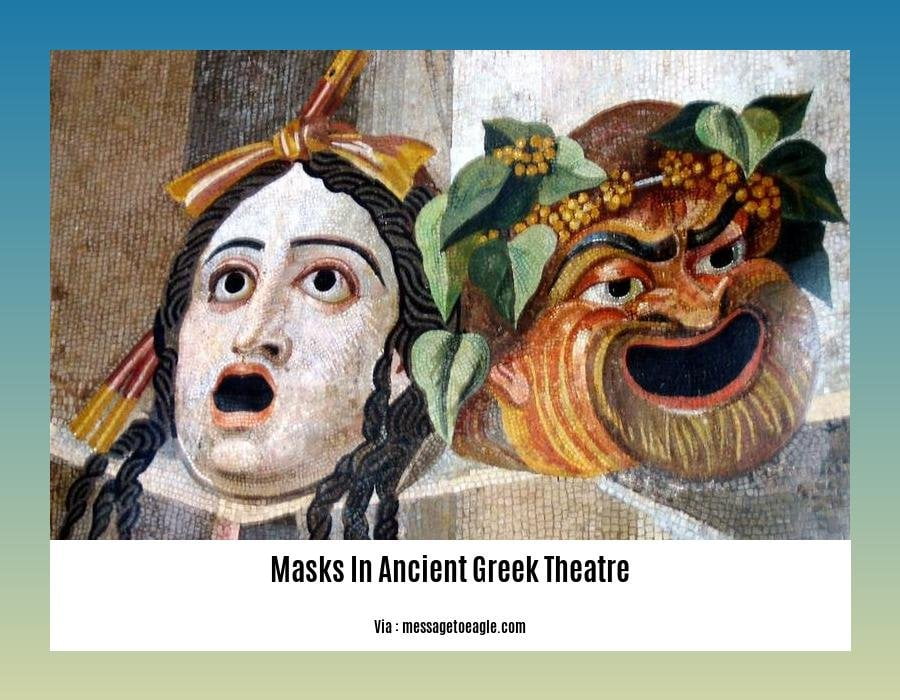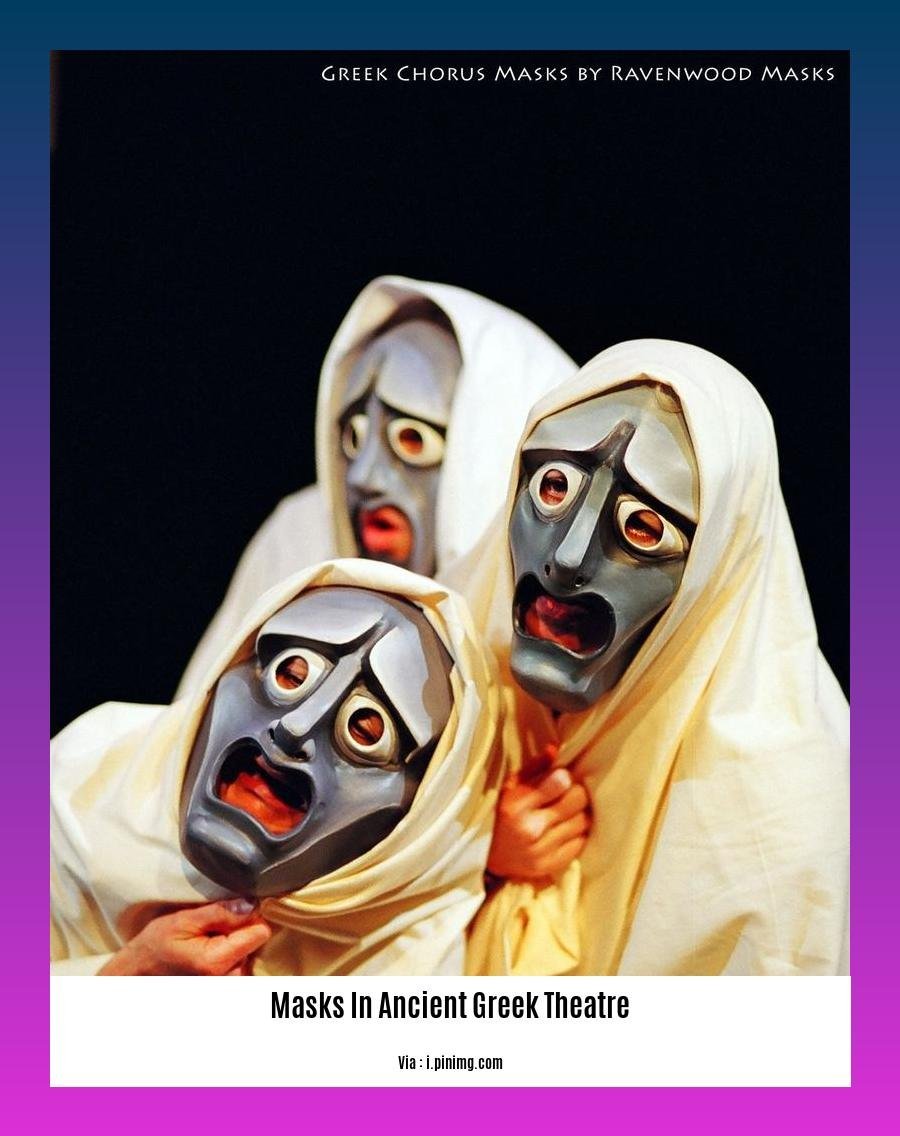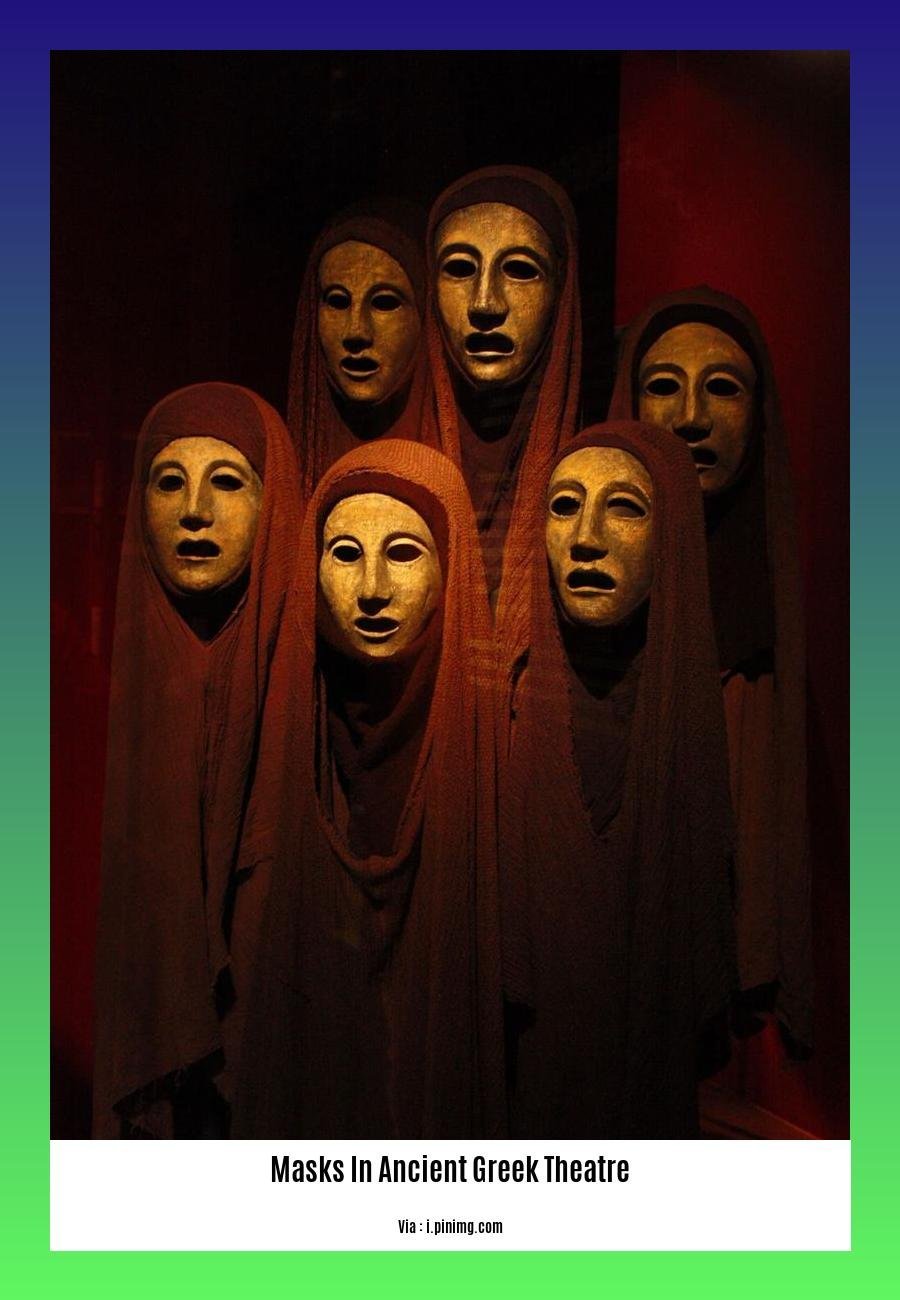Step back in time to the world of ancient Greek theatre, where grand stages lay beneath the open sky, and larger-than-life masks held the audience spellbound. These masks weren’t mere disguises; they were instruments of transformation, allowing actors to embody gods, heroes, and mythical creatures with captivating power. Join us as we delve into the fascinating world of these ancient masks and uncover the secrets behind their enduring legacy.

Masks in Ancient Greek Theatre
Imagine a stage devoid of intricate sets or dazzling special effects, where the power of storytelling rested solely on the actors and their evocative masks. In ancient Greece, these masks were far more than just props—they were the very essence of the theatrical experience.
Making Faces in a Crowd: Why Masks Mattered
Picture yourself amidst a throng of thousands gathered in a vast, open-air theatre. Even with booming voices, actors faced a challenge—how to be seen and heard from the back row? The answer lay in the masks. Their exaggerated features, from wide, staring eyes to gaping mouths, amplified expressions, turning subtle emotions into grand gestures visible from afar.
This visual amplification was crucial for conveying the nuances of each character’s emotional journey. A furrowed brow etched in clay spoke volumes of a king’s anguish, while a mask frozen in a wide, toothy grin instantly signaled a mischievous trickster.
One Actor, Many Roles: The Magic of Transformation
One of the most intriguing aspects of ancient Greek theatre was the fact that men played all the roles, including female characters. How did they achieve such versatility? You guessed it—masks! With a simple change of mask, an actor could seamlessly transition from a powerful king to a grieving mother, a testament to the transformative power of these theatrical tools.
This wasn’t just a matter of convenience; it added a layer of symbolism to the performances. The mask, not the actor’s physical appearance, defined the character, emphasizing the idea that any individual could embody the essence of a god, hero, or monster.
A Mask for Every Mood: Instant Character Recognition
In plays featuring a multitude of characters, how did the audience keep track of who was who? Masks provided a simple yet effective solution. Tragedy masks, often depicting sorrow, pain, or anguish, instantly set a somber tone, while comedic masks, with their exaggerated grins and rosy cheeks, promised laughter and lighthearted amusement. It was like having a visual shorthand for emotions, allowing the audience to instantly connect with the characters and the unfolding drama.
| Mask Type | Appearance | Emotion Conveyed |
|---|---|---|
| Tragedy Mask | Somber expression, often with tears or a frown | Sorrow, grief, despair |
| Comedy Mask | Exaggerated grin, sometimes with rosy cheeks | Joy, amusement, wit |
Projecting Power: Voices that Boomed
Ancient Greek theatres were architectural marvels, renowned for their impressive acoustics. But even the most ingenious design couldn’t compete with the power of the masks. These cleverly crafted creations acted as miniature megaphones, projecting the actors’ voices toward the audience, ensuring that every word, every whisper, every cry of despair resonated throughout the theatre. No one missed a single beat of the drama unfolding on stage.
Beyond the Surface: The Enduring Power of Masks
While the practical purposes of masks are undeniable, their impact on ancient Greek theatre extended far beyond mere functionality. They blurred the lines between actor and character, creating an otherworldly aura that captivated audiences. Even today, the legacy of masks in theatre reminds us of the power of symbolism, transformation, and the enduring magic of storytelling.
Dive deep into the annals of time and explore the tapestry of ancient history. Discover pivotal historical events in the important events in ancient history timeline, unravel the intricacies of ancient India’s major port cities by clicking on important port city in ancient india, and illuminate your understanding of ancient Indian history through its rich literary sources of ancient indian history.

The Divine Connection: How Masks Linked Actors to Gods in Greek Theatre
Imagine a stage where actors didn’t just portray gods—they practically became them. That’s the power masks held in ancient Greek theatre. These weren’t mere disguises; they were conduits to the heavens, transforming actors into living embodiments of the divine.
When an actor donned a mask, they weren’t simply changing their appearance; they were channeling the very essence of a god, stepping into a sacred role that connected them to the myths and beliefs at the heart of Greek culture.
These masks weren’t just for show. Their design played a crucial role in amplifying the actors’ voices, allowing them to project their words across those vast amphitheaters. Think of it as an ancient microphone, ensuring that even those in the back row could hear and be moved by the performance.
Remember, Greek theatre was deeply rooted in religious rituals, especially those honoring Dionysus, the god of theatre himself. The masks themselves became sacred objects, linking every performance to those ancient ceremonies. The actors weren’t just performing; they were participating in a sacred act, blurring the lines between entertainment and religious experience.
The exaggerated features of the masks, the huge smiles or fierce frowns, were carefully crafted to ensure that every emotion was crystal clear to the audience. Even from afar, you could instantly tell a hero from a villain, a god from a mortal. These visual cues made the stories come alive in a way that words alone never could, creating a powerful and immersive experience for the audience.
Those masks weren’t just props; they were the bridge between the stage and the heavens, allowing actors to embody the divine and transport audiences to a world of gods and heroes.
Expressing the Unspeakable: The Role of Masks in Conveying Emotion
Imagine a stage bathed in the warm Mediterranean sun, where actors adorned with larger-than-life masks command the attention of thousands. These masks weren’t just about hiding faces; they were megaphones for emotions, broadcasting every subtle shift and dramatic outburst to the far reaches of those ancient amphitheatres.
In such a vast space, tiny facial twitches wouldn’t do. Those exaggerated features, those gaping mouths frozen in eternal cries or silent laughter—they spoke volumes. It’s like the difference between whispering and bellowing; masks helped actors transform human feelings into something powerful and unforgettable.
But these masks weren’t just about being loud. They were deeply intertwined with the spiritual fabric of Greek culture. Picture wearing a mask and suddenly becoming a god, a monster, a mythical hero. The mask was a portal, a way for actors to shed their humanity and connect with the divine forces that shaped their world. The audience wasn’t just watching a performance; they were witnessing the gods themselves come to life.
Even today, centuries later, the legacy of those masks still resonates. Think about the elaborate makeup used in theatrical productions today, or the way a single prop can instantly transform an actor into someone else. The spirit of those ancient masks lives on, reminding us that sometimes, the most powerful way to express ourselves is to become something more than just human.
| Feature of Greek Masks | Purpose | Modern Equivalent |
|---|---|---|
| Exaggerated Features | Project emotions clearly | Bold stage makeup, exaggerated movements |
| Oversized Mouths | Amplify vocal projection | Microphones, vocal techniques |
| Fixed Expressions | Convey specific emotions | Character-specific makeup, prosthetics |
The next time you see a play or a movie, pay attention to the subtle ways emotions are conveyed. You might just catch a glimpse of those ancient Greek masks, still whispering their secrets across the centuries.
Behind the Mask: Character Development and Storytelling in Ancient Greek Theatre
Imagine yourself transported back in time to an open-air theater in ancient Greece. The sun beats down as you find your seat among the bustling crowd, eager for the play to begin. As the actors take the stage, they’re not just wearing costumes – they’re donning elaborate masks, each one a work of art that hints at the character they’re about to embody. These masks weren’t just about hiding faces; they were the heart and soul of Greek theatre, breathing life into characters and stories in ways we’re still unraveling today.
More Than Meets the Eye: Masks as Storytelling Tools
Think of these masks as the original special effects, instantly transforming actors into a whole cast of characters. One minute an actor might be a mighty king, the next a weeping widow, all thanks to the power of the mask. This quick-change artistry kept the story flowing smoothly and allowed for a richness of characters that wouldn’t have been possible otherwise. It was like watching a live-action comic book unfold before your very eyes!
But these masks were more than just costume changes. They amplified emotions with an almost magical effect. Imagine exaggerated features – a furrowed brow etched in clay for sorrow, or a wide, gaping mouth frozen in a scream of terror. These bold expressions, easily visible even from the back row, allowed the audience to connect with the characters on a visceral level. It was like the emotions themselves were given a physical form, powerful and impossible to ignore.
From Stage to Soul: The Deeper Meaning of Masks
The impact of these masks went beyond mere entertainment. They were deeply intertwined with the religious beliefs of the time. Remember, Greek theatre was born from rituals honoring Dionysus, the god of wine, revelry, and transformation. The masks became a tangible link to the divine, allowing actors to embody gods and mythical beings, blurring the lines between the earthly and the supernatural. It’s no wonder audiences felt a sense of awe and wonder watching these masked figures command the stage.
A Legacy That Lives On
The influence of these ancient masks extends far beyond the ruins of Greek theaters. Their legacy lives on in the dramatic arts even today. Think about modern productions that incorporate masks, from haunting Noh theatre in Japan to experimental plays pushing the boundaries of storytelling. Masks continue to fascinate us with their power to explore identity, symbolism, and the very essence of what it means to be human.
So, the next time you encounter a mask, whether in a museum or on a stage, take a moment to appreciate its rich history. It’s a reminder that some of the most powerful stories are told not just with words, but with the evocative expressions frozen in time on a sculpted face.
















